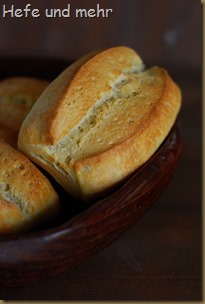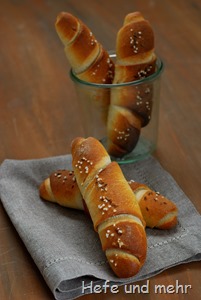
I asked at the last Bread baking course post if you have special breads you would like to bake. And Uschi then asked for recipe for “Salzstangerl”. These are long rolls sprinkled with salt and caraway seeds and they can be found mainly in Austria. And as I planed to bake the next bread in our course with Pâte Fermentée as preferment these rolls fitted very well in my plans for the weekend.
The Pâte Fermentée contains flour, yeast, salt and water. It can be either a part of a bread dough which is kept in the fridge (that’s why some people call it “Old dough”) or it can be mixed and fermented as a normal prefermt (what I do most of the time). It adds a part of full develope gluten network to the dough which helps to improves the gluten structure. The flavour notes are complex, a little bit nutty and only slightly sour.

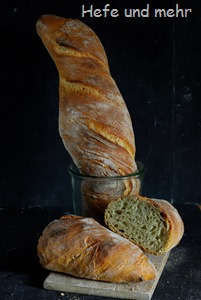 In the last days, the weather was warm and sunny and it finally feels like real spring. The first trees started to flower and the leaves will develop soon and the world will be green once again. And already the first fresh herbs can be found in garden and forest, like wild garlic, ground elder and salad burnet. Blended together this herbs yields an aromatic paste which adds a great flavour to this crusty bread and turns the crumb slightly green.
In the last days, the weather was warm and sunny and it finally feels like real spring. The first trees started to flower and the leaves will develop soon and the world will be green once again. And already the first fresh herbs can be found in garden and forest, like wild garlic, ground elder and salad burnet. Blended together this herbs yields an aromatic paste which adds a great flavour to this crusty bread and turns the crumb slightly green.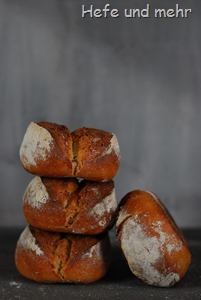
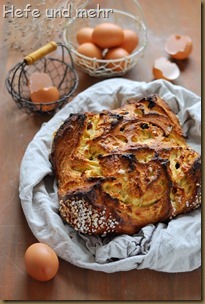 Last weekeend I realized how near Eastern is when my mom told me on the phone about her plans of dyeing eggs with her kids at school. And so I changed my plans for the bread baking course and developed a sweet recipe perfect for the Easter Breakfast. It is a sweet bread called which is made with the biga preferement. The subtle acidity of it helps to strengthen the gluten network. For a tender crumb the dough contains cream, egg yolk and some butter. By replacing the butter with cream the dough can rise in the fridge if needed.
Last weekeend I realized how near Eastern is when my mom told me on the phone about her plans of dyeing eggs with her kids at school. And so I changed my plans for the bread baking course and developed a sweet recipe perfect for the Easter Breakfast. It is a sweet bread called which is made with the biga preferement. The subtle acidity of it helps to strengthen the gluten network. For a tender crumb the dough contains cream, egg yolk and some butter. By replacing the butter with cream the dough can rise in the fridge if needed.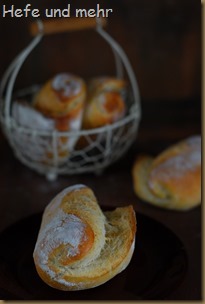 I mentioned already once or twice that I like to at
I mentioned already once or twice that I like to at 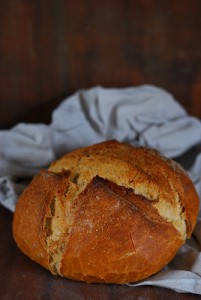
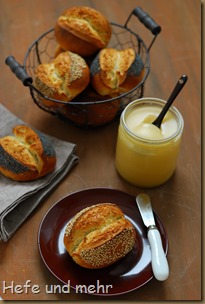 To me, the basic of good breakfast is a good roll. And so we are baking rolls in part three of our little bread baking course. These rolls are looking more complicated then they. For shaping we will use the same method then for the bread we baked last time. And already after 15 minutes the rolls are deeply cut, which is much easier than cutting a fully proofed roll. The cut is carefully laid together and will open beautiful during baking.
To me, the basic of good breakfast is a good roll. And so we are baking rolls in part three of our little bread baking course. These rolls are looking more complicated then they. For shaping we will use the same method then for the bread we baked last time. And already after 15 minutes the rolls are deeply cut, which is much easier than cutting a fully proofed roll. The cut is carefully laid together and will open beautiful during baking.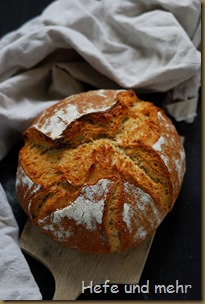 I got a lot of positive feedback to my idea of making a small virtual bread baking course. I’m very happy about it and will start to post more beginner recipes on the blog in the next weeks. And if you have questions, ideas or wishes: Please tell me! I will do my best to include it.
I got a lot of positive feedback to my idea of making a small virtual bread baking course. I’m very happy about it and will start to post more beginner recipes on the blog in the next weeks. And if you have questions, ideas or wishes: Please tell me! I will do my best to include it.